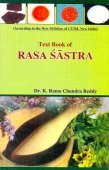Rasaraja, Rasa-raja, Rasarāja: 11 definitions
Introduction:
Rasaraja means something in Hinduism, Sanskrit. If you want to know the exact meaning, history, etymology or English translation of this term then check out the descriptions on this page. Add your comment or reference to a book if you want to contribute to this summary article.
In Hinduism
Purana and Itihasa (epic history)
Source: Cologne Digital Sanskrit Dictionaries: The Purana IndexRasarāja (रसराज).—One of the eight saubhāgyams.*
- * Matsya-purāṇa 60. 8, 28.

The Purana (पुराण, purāṇas) refers to Sanskrit literature preserving ancient India’s vast cultural history, including historical legends, religious ceremonies, various arts and sciences. The eighteen mahapuranas total over 400,000 shlokas (metrical couplets) and date to at least several centuries BCE.
Ayurveda (science of life)
Rasashastra (Alchemy and Herbo-Mineral preparations)
Source: Wisdom Library: Rasa-śāstraRasarāja (रसराज) is the name of an Ayurvedic recipe defined in the fourth volume of the Rasajalanidhi (chapter 2, dealing with jvara: fever). These remedies are classified as Iatrochemistry and form part of the ancient Indian science known as Rasaśāstra (medical alchemy). However, as an ayurveda treatment, it should be taken twith caution and in accordance with rules laid down in the texts.
Accordingly, when using such recipes (e.g., rasarāja-rasa): “the minerals (uparasa), poisons (viṣa), and other drugs (except herbs), referred to as ingredients of medicines, are to be duly purified and incinerated, as the case may be, in accordance with the processes laid out in the texts.” (see introduction to Iatro chemical medicines)
Unclassified Ayurveda definitions
Source: gurumukhi.ru: Ayurveda glossary of termsRasarāja (रसराज):—Mercury – one of the synonym of mercury

Āyurveda (आयुर्वेद, ayurveda) is a branch of Indian science dealing with medicine, herbalism, taxology, anatomy, surgery, alchemy and related topics. Traditional practice of Āyurveda in ancient India dates back to at least the first millenium BC. Literature is commonly written in Sanskrit using various poetic metres.
Languages of India and abroad
Sanskrit dictionary
Source: DDSA: The practical Sanskrit-English dictionaryRasarāja (रसराज).—
1) = रसाञ्जन (rasāñjana).
2) quick-silver.
Derivable forms: rasarājaḥ (रसराजः).
Rasarāja is a Sanskrit compound consisting of the terms rasa and rāja (राज). See also (synonyms): rasaloha.
Source: Cologne Digital Sanskrit Dictionaries: Shabda-Sagara Sanskrit-English DictionaryRasarāja (रसराज).—m.
(-jaḥ) Quicksilver. E. rasa a mineral, rāja sovereign.
Source: Cologne Digital Sanskrit Dictionaries: Aufrecht Catalogus Catalogorum1) Rasarāja (रसराज) as mentioned in Aufrecht’s Catalogus Catalogorum:—med. Rādh. 32.
2) Rasarāja (रसराज):—med. Rgb. 938.
Source: Cologne Digital Sanskrit Dictionaries: Monier-Williams Sanskrit-English Dictionary1) Rasarāja (रसराज):—[=rasa-rāja] [from rasa > ras] m. = -nātha, [cf. Lexicographers, esp. such as amarasiṃha, halāyudha, hemacandra, etc.]
2) [v.s. ...] = rasāñjana, [cf. Lexicographers, esp. such as amarasiṃha, halāyudha, hemacandra, etc.]
3) [v.s. ...] Name of [work] on medicine
Source: Cologne Digital Sanskrit Dictionaries: Yates Sanskrit-English DictionaryRasarāja (रसराज):—[rasa-rāja] (jaḥ) 1. m. Quicksilver.
[Sanskrit to German]
Sanskrit, also spelled संस्कृतम् (saṃskṛtam), is an ancient language of India commonly seen as the grandmother of the Indo-European language family (even English!). Closely allied with Prakrit and Pali, Sanskrit is more exhaustive in both grammar and terms and has the most extensive collection of literature in the world, greatly surpassing its sister-languages Greek and Latin.
Nepali dictionary
Source: unoes: Nepali-English DictionaryRasarāja (रसराज):—n. 1. poetics. the principal rasa: the amatory (sringar); 2. mercury;
Nepali is the primary language of the Nepalese people counting almost 20 million native speakers. The country of Nepal is situated in the Himalaya mountain range to the north of India.
See also (Relevant definitions)
Partial matches: Rasa, Raca, Raja.
Starts with: Rasarajahamsa, Rasarajalakshmi, Rasarajashamkara, Rasarajashankara, Rasarajashiromani.
Query error!
Full-text: Rasarajalakshmi, Rasarajahamsa, Rasarajashamkara, Rasarajashiromani, Rasanayaka, Rasraj, Saubhagyashtaka, Rasaloha, Shrrimgara.
Relevant text
Search found 15 books and stories containing Rasaraja, Rasa-raja, Rasa-rāja, Rasarāja; (plurals include: Rasarajas, rajas, rājas, Rasarājas). You can also click to the full overview containing English textual excerpts. Below are direct links for the most relevant articles:
Journal of the European Ayurvedic Society (by Inge Wezler)
Ayurvedic manuscripts in the Cambridge University Library < [Volume 1 (1990)]
Notices of Sanskrit Manuscripts (by Rajendralala Mitra)
Page 201 < [Volume 4 (1877)]
Vastu-shastra (Introduction to Indian architecture) (by D. N. Shukla)
Chapter 3f - The Aeroplane (Vimāna-yantra) < [Volume 4 - Palace Architecture]
Satirical works of Kshemendra (study) (by Arpana Devi)
9.6. Summary of the Kṛpābor Baruar Kākator Topolā (1905) < [Chapter 1 - Introduction]
Rasa Jala Nidhi, vol 4: Iatrochemistry (by Bhudeb Mookerjee)
Treatment for fever (129): Rasaraja rasa < [Chapter II - Fever (jvara)]
International Ayurvedic Medical Journal
Role of ayurveda in the management of ankylosing spondylitis – a case report < [2022, Issue 10, October]
A review on rasoushadhis used in mootravaha sroto dusti /vikara < [2020, Issue 4, April]
Manashila: an in-depth analysis through the classical texts < [2024, Issue 06. June]
Related products
